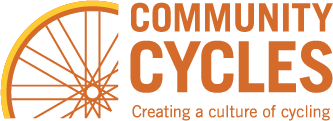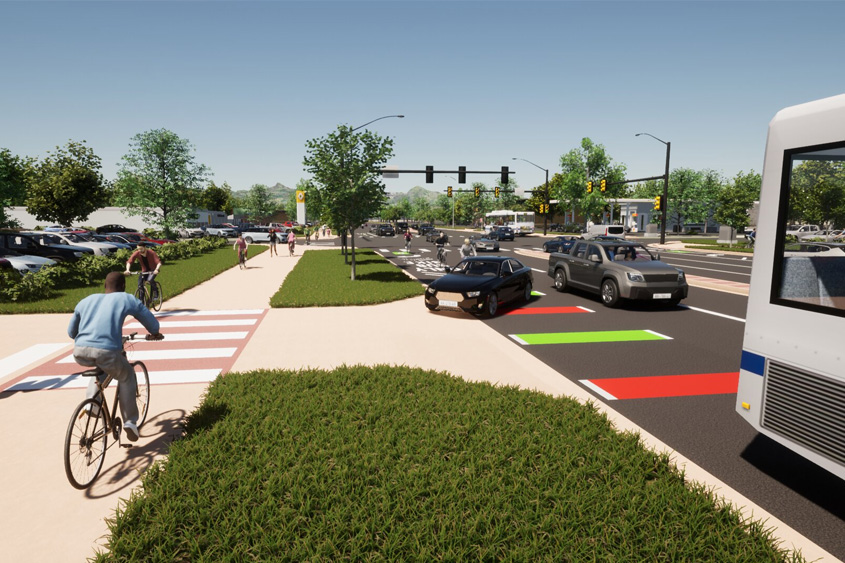Dear Staff and TAB:
The Community Cycles Advocacy Committee would like to thank Staff for presenting to us the proposed design for the north segment of 28th St (Canyon to Iris). We were pleased that the design includes raised crossings at all driveways, and some novel use of colored pavement markings.
Unfortunately, we were deeply disappointed to see a design that, at its heart, is based on concepts and conventions of transportation engineering that are more than 20 years old, and that fail to incorporate many recent innovations in human-centered urban transportation design.
As Staff stated in our meeting, the basic design for 28th Street was set around 1998. In 1998, protected bike lanes hadn’t even been invented. In 1998, expediting motor vehicle flow was still the primary objective for the city’s transportation design. In 1998, climate change still felt like a vague and far-off threat. In 1998, no one had heard the term “Vision Zero”.
A 1998 design is not what we need today.
The design is particularly lacking for people biking. The designated “BBAT” lanes, which would mix bikes with right-turning motor vehicles as well as with buses starting and stopping, all immediately adjacent to traffic that can reasonably be expected to travel at 40mph, are terrifying for the vast majority of bicycle riders, and would only discourage potential bicyclists.
The multi-use path, which entices bikes to go fast but then subjects them to conflict with turning cars at intersecting streets and numerous driveways, are all too reminiscent of the deeply flawed Broadway Path in the vicinity of Table Mesa Shopping Center, where pedestrians, bicyclists, and motor vehicles all conflict dangerously.
Moreover, adding two lanes to the street will increase capacity, especially for through traffic, resulting in higher VMT and more pollution. By removing the obstacles for turning vehicles and stopping buses, this design will lead to higher motor vehicle speeds.
All of these outcomes are directly contrary to our TMP and Vision Zero goals. In fact, in the “Report on Progress” the city released in January, VMT reduction, mode share, and GHG reduction were all in the yellow/red zone, and are trending in the wrong direction. Safety was firmly in the red or troubling zone. Auto travel time — the one thing this project does improve — is already the green zone.
Why is the city investing in such an enormous infrastrastructure project whose impact is primarily to move us further from our desired outcomes? Ideally, we would be discussing a 2021-era design, or even a 2030-era design, instead of a 1998-era design.
However, we understand that funding and political realities mean that the core design is unlikely to change. Given that, we request that as much as possible be done “around the edges” to salvage it, with the goal of improving safety and comfort in the context of a fundamentally flawed design.
Specifically, we request the following design details:
- A hardened center line through the entire project to prevent mid-block left turns, which would be particularly dangerous to people on the multi-use path.
- Signal progression speed of no more than 30mph.
- Fully protected left turns and right-turn-on-red restrictions at all intersections.
- Raised crossings elevating the multi-use path at all unsignalized intersections.
- Much-reduced corner radii at driveways and street intersections, to ensure slower, safer turns.
- All driveway widths including MUP crossings to be no greater than 15’, the minimum allowed in the Design and Construction Standards (see DCS Table 2-2).
- Speed cameras (if permitted) and photo red-light cameras throughout the corridor.
- Creation of a signal coordination group consisting solely of the signals on this section of 28th St, so that signal cycle lengths can be minimized.
- Reduce the speed limit to 30 MPH throughout this section.
- Remove bikes from the BBAT lane. Adding bikes to this lane is too dangerous. Bicyclists should not be encouraged to ride in these lanes and considering these lane miles as “bicycle facilities” is disingenuous.
While these considerations cannot fully compensate for a backward-looking design, they could improve the safety and comfort of people walking and biking. We strongly urge the city to incorporate these into the plan. Without them, the result will be an even larger step in the wrong direction.
We also request that if this design goes forward, parallel routes for non-motorized modes be prioritized.
Staff made clear in their presentation that the proposed design is not intended to welcome people walking or biking longer distances in the north-south direction, and suggested that those people should choose alternate routes. But to do so, they need safe facilities: namely, well-designed, protected bike facilities and safe, comfortable sidewalks that minimize conflicts with turning cars and bikes.
Staff in effect stated that people walking and biking are being deprioritized on 28th St in the interest of motor vehicle traffic. If that is to be the case, then it is only appropriate that parallel corridors, namely Folsom and 30th Streets, be designed primarily for walking and biking, with the convenience and expediency of cars explicitly placed in a secondary position.
The Folsom and 30th street projects should happen now.
It is unconscionable that the city is choosing to prioritize yet another fast moving, dangerous road through the middle of town before creating a single safe north south corridor east of Broadway. This project should be sidelined until real safety improvements on Folsom and 30th street are made.
Finally, we have to wonder: what other 20-year-old bad plans are waiting in the wings to be built? This is not the first time in recent years that an old project with outdated designs has been brought forward. Projects like this, with unsafe and outdated designs that do not match the city or the community’s current goals, should be scrapped, rather than lingering in a file to be resuscitated when funding becomes available.
Thank you so much for your time and attention.
Community Cycles Advocacy Committee

